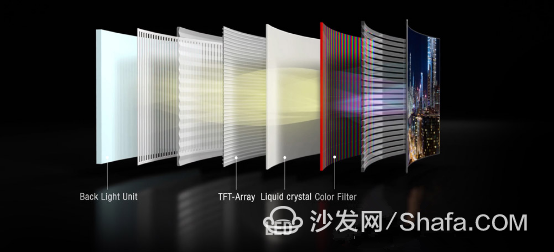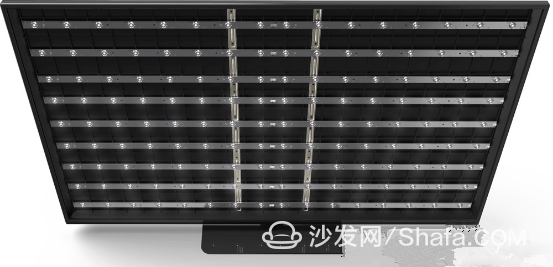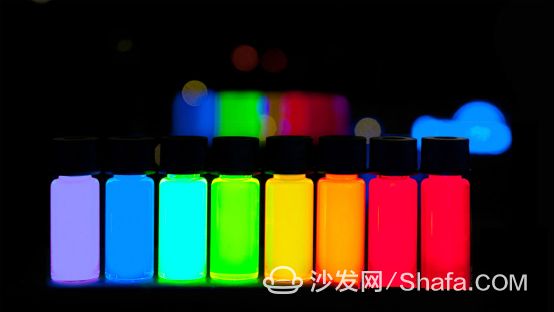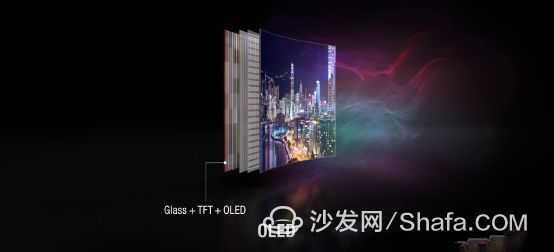
LCD display

In the LCD display, it is very difficult to completely cover the white display black, and there will always be some light leakage phenomenon, and this is why it cannot be really black on most of the night view screens. s reason.
Passive and active matrix
The LCD display has been used since the 1980s and was first used on "laptops." These screens have a "matrix" array of pixels and are divided into active and passive matrices. The active matrix technology is more advanced and allows finer control and faster switching than passive matrix. The active matrix technology was introduced for the first time using the TFT affinity matrix screen, but later there were more variant technologies, but they were all basically the same working principle and the costs continued to decrease.
LCD backlight
All LCD displays require some form of white backlighting, and backlight technology continues to improve over time. The purpose of the backlight is higher brightness, more uniform illumination, and smaller, thinner, and lighter displays.
The LCD screen originally used CCFL backlighting, but it has now been changed to LED backlighting. In addition, some liquid crystal displays have not only used white backlights, but have even achieved some more difficult purposes through the combination of LED backlights of certain colors and white light.

TV products generally do not have such a high requirement for thickness, and therefore the overall uniform backlighting method is also used, and such light can be more uniform, and backlight adjustment can also be performed for a part.
LCDIPS and PLS

The IPS can completely reproduce the color effect within 178 degrees without any influence. This is also the reason that most touch devices now use IPS displays. That's right, traditional LCD screens have strange effects when they are pressed with fingers. I believe everyone has had a similar experience.
PLS (Plane LineSwitching) is a similar technology to IPS and is a patent of Samsung. Samsung said that this kind of screen has better brightness and more efficient production costs, but it is still uncertain, because the absolute leader of the IPS display on the market is LG.
LCD+ Quantum Dots

Quantum dot technology has recently been hotly sought after by the market, and even has the strength and OLED this latest technology Pimen. However, quantum dot technology currently exists only in high-end LCD TVs, but it is believed that it will gradually become popular over time.
OLED screen

Due to the special properties of OLEDs, it is not necessary to cover the light source like the LCD when displaying black, and only the pixels need to be extinguished to not emit light. And that's why OLED displays bring true "black". OLED's black color is very deep, and its contrast is extremely high. At the same time, it can even produce amazing effects when compared with elements such as white.
OLED technology first appeared in the laboratory in 1987, and has now become a very popular technology in the field of smart phones. Because OLED screens are one layer less than LCD screens, one-time thickness control is even thinner, and this is especially important for mobile devices. For TV products, whether to choose OLED products depends on the user's preferences. However, we believe that the slimness of OLEDs is not a decisive advantage for LCD TVs.
One-to-one comparison
Due to the difference in basic properties, we can look at the direct comparison between two different principles of imaging technology, giving users a more intuitive experience.
Black level: OLED wins
The black level refers to the extent to which the screen can show "black" when displaying the darkest color. Since technologies such as LCD, DLP, or projection rely on filtering or blocking white light, it is very difficult to display true black. In fact, it can be said that the LCD screen cannot bring true black at all. After all, the shielding effect is no better, or there will be some light leakage. On the other hand, due to the principle of self-luminescence, OLEDs can bring true black by turning off the lighting mechanism.
Contrast: OLED wins
Contrast refers to the difference between the brightest white and the darkest black, while the LCD has an advantage in brightness (especially in HDR mode), while the OLED has the darkest black. In general, OLED displays generally have higher contrast because the advantage of the black level will amplify the difference.
Perspective: OLED wins
Perhaps the best IPS screens are comparable to OLED screens, but most LCD screens are not as good as IPS (especially TVs and smart phones), so in addition to the top IPS screens, Compared with OLEDs, LCD panels have slightly inferior viewing angle performance. In front of OLED TVs, whether the audience is sitting at that angle, they can see the content on the screen with high quality.
Color gamut: OLED wins
From the aspect of paper parameters, the advantage of OLED in color gamut is not obvious, mainly because the LCD panel now introduces quantum dot technology. Basically the best LGOLED TVs and Samsung's top quantum dot LCD TVs are comparable in color gamut.
But usually only the best LCD TVs are comparable to OLED TVs, so overall the color gamut is better than OLEDs.
Brightness level: LCD wins
Since LCD TVs typically use separate backlighting, they generally provide better brightness. In reality, the best LCDs and OLEDs have a difference of about 400 NIT in brightness. Overall, LCDs are superior in brightness level. You know, higher brightness will make the screen have better visual effects outdoors or in the daytime room.
HDR
HDR mode can increase brightness by 1000 to 10,000 NIT, while HDR-enabled OLED TVs are comparable in brightness to LCD TVs. However, some Sony LCD TVs can increase the brightness to 1000 to 1300 NIT, so overall, LCD TVs are much brighter.
Color uniformity: OLED wins
Whether it is possible to display various colors on a single plane in a uniform manner is a very important indicator. Because the backlight of the LCD screen usually comes from the edge, it is more general in terms of illumination uniformity. If the backlight can be evenly dispersed behind the screen, the discrete backlight can bring better results.
On the other hand, OLEDs have to perform much better in this respect. Since each pixel can emit light on its own, no light source diffusion is required. In real life, even if the OLED display is not completely unified, there is even a flexible OLED, but overall it is still better than LCD.
Power consumption: LCD wins
At the same brightness level, the LCD consumes less energy than the OLED. This is a problem we have to face. For mobile devices, higher brightness means better visibility outdoors, and products like TVs need only have enough brightness during the day.
On the other hand, the power consumption of the OLED panel depends on how many pixels there are, so the OLED screen with higher resolution consumes more power.
Cost efficiency: LCD wins
Currently, LCD is the lowest cost display method, but OLED technology is continuously optimized with continuous progress and time. It is unclear how much the specific cost rate is, but in the future, OLED technology will continue to improve. Ultimately, it will continue to be optimized and reduced in cost, and it will eventually rival the LCD.
Summary: OLED is the best, but it needs development
In general, OLED has won a lot in the parameter comparison of image quality, so the future can be said to be a development trend of future display technologies. However, OLEDs are still limited by the cost of production, and the size has also encountered a bottleneck. Unless you have special requirements on the specific parameter of brightness, OLED will be stronger than LCD on most display parameters.
However, the cost is also an aspect that has to be considered. The smart phone is better if it is like a TV.
The main function of the Home Energy Storage System is to store the electricity generated by the solar panels in the home photovoltaic power generation system, so as to continue to supply electricity at night, cloudy days, or when the electricity demand exceeds the supply of the solar panels. It is an energy storage solution for improving the self-sufficiency and energy efficiency of home photovoltaic power generation systems.
Main effect:
Energy Storage: The Home Energy Storage System uses batteries to store excess electricity generated by the home's photovoltaic power generation system. When solar panels generate more power than the household needs, the excess power is stored in the battery to continue supplying power when needed.
Power supply backup: At night, on cloudy days or when the power generated by solar panels is insufficient, the Home Energy Storage System can use the stored power to continue to supply power to ensure the continuity and stability of household power consumption.
Energy balance: The Home Energy Storage System helps to balance the energy difference between the electricity generated by the home photovoltaic system and the electricity demanded, thereby optimizing energy management and maximizing self-sufficiency.
Differences from other energy storage systems:
Power source: The power source of the Home Energy Storage System is the Solar Panel of the home photovoltaic power generation system, which directly generates electricity by converting sunlight. While other energy storage systems may come from other renewable energy sources, such as wind energy, hydro energy, or non-renewable energy sources, such as grid electricity.
Renewable: The Home Energy Storage System uses solar energy as a power source and is a renewable energy system. Other energy storage systems may utilize different types of energy sources, with varying degrees of renewability.
Application Scenario: Home Energy Storage System is mainly used in home photovoltaic power generation systems, especially in conjunction with solar panels. Other energy storage systems can be used in different energy generation systems, selected according to specific energy sources and application requirements.
Overall, the main function of the Home Energy Storage System is to store the electricity generated by the solar panels for continued supply of electricity at night, on cloudy days, or when the home's electricity demand exceeds the supply of the solar panels. Compared with other energy storage systems, it uses solar energy as a power source, is a renewable energy system, and is mainly used in household photovoltaic power generation systems to improve energy utilization efficiency and self-sufficiency.
residential energy storage system, solar lithium battery storage, solar panel and battery system for home, solar battery storage for house, household solar battery storage
Ningbo Autrends International Trade Co., Ltd. , https://www.china-energystorage.com